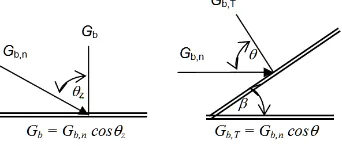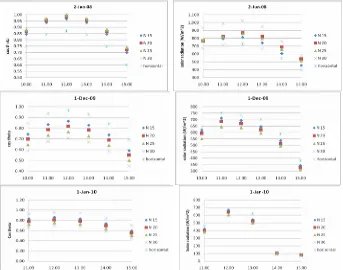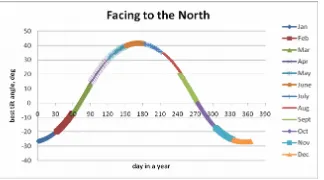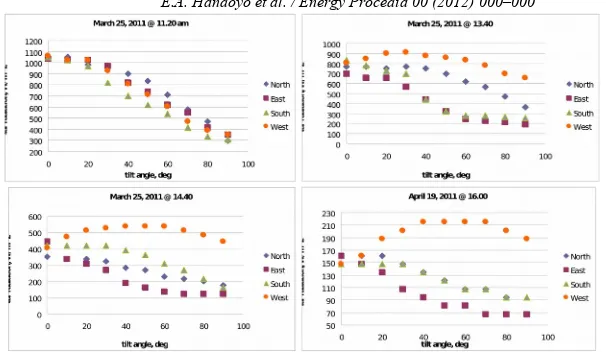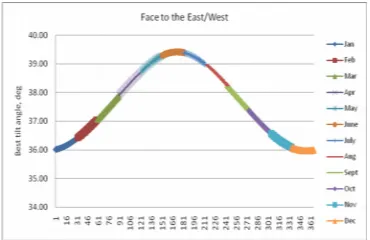Available online at www.sciencedirect.com
Energy Procedia 00 (2012) 000–000
www.elsevier.com/locate/procedia
International Conference on Sustainable Energy Engineering and Application
[ICSEEA 2012]
The optimal tilt angle of a solar collector
Ekadewi A. Handoyo
a,b,1, Djatmiko Ichsani
a, Prabowo
aaMechanical Eng. Dept of Sepuluh Nopember Institute of Technology, Surabaya– Indonesia bMechanical Eng. Dept of Petra Christian University, Surabaya – Indonesia
Abstract
A solar collector is used to heat water or air. Its efficiency will increase when it is always facing the sun. But, it means a tracking system is required. A tracking system is too expensive for farmers. To help the farmers, a research is done to find the optimal angle of installing a solar collector. The optimal tilt angle is the angle where the solar
radiation will arrive perpendicularly upon the surface. When the angle of incidence of beam radiation on a surface, ,
is smaller, then its cosine will be larger. Maximizing “cos“ on a surface can maximize the solar radiation received
on that surface. Thus, the optimal tilt angle of the collector is obtained from the first derivative of cos with respect
to the tilt angle. Then, the result, i.e. Equation (2) is compared to the work of Tang et al., Duffie and Beckman’s equations, and some experiments on some days in March, April 2011, June 2008, December 2009, and January 2010 in Surabaya, Indonesia.
It can be concluded that Equation (2) is valid to obtain the optimal tilt angle of a collector to get maximum solar radiation. For a collector installed in Surabaya, the optimal tilt angle during March 12 – September 30 is varied
between 0 – 40o (face to the North) and during October 1 – March 11 is between 0 – 30o (face to the South). Other
choice is installing two collectors, i.e. one facing to the East to be used in the morning and one to the West in the
afternoon. The optimal tilt angle for these orientations is 36 – 39.4o.
© 2012 Published by Elsevier Ltd.
Selection and/or peer-review under responsibility of Research Centre for Electrical Power and Mechatronics, Indonesian Institute of Sciences
Keywords: tilt angle; solar collector; angle of incidence of beam radiation
1* Corresponding author. Tel.: +62-31-2983465; fax: +62-31-8491215.
E.A. Handoyo et al. / Energy Procedia 00 (2012) 000–000 1. Introduction
For a country near to the equator, solar energy is a blessing natural resource that plays an important role in the future because the shortage of fossil fuels. Solar energy can be converted to electricity via a photovoltaic (PV) cell or thermal energy via a solar collector to heat either water or air. The amount of solar radiation received on a collector depends on latitude, day of the year, slope or tilt angle, surface azimuth angle, time of the day, and the angle of incident radiation. The factors that can be controlled to maximize the amount of radiation flux received upon the collector are surface azimuth angle and tilt angle by installing a collector properly.
Duffie and Beckman [1] gives “rules of thumb” that to give maximum annual energy availability, a surface slope equal to latitude is the optimal and the surface should face the equator. It means a solar collector in southern hemisphere should face to the North with slope equal to its latitude to get maximum solar radiation. El-Sebaii et al. [2] found that at Jeddah, the solar energy devices have to be tilted to face south with a tilt angle equals the latitude of the place in order to achieve the optimal performance all year round. Danny H.W. Li et al. [3] used the whole 2004 year 10-minute horizontal radiation and sky radiance data recorded in Hong Kong for the analysis. The incident solar radiation data on various inclined surfaces facing different 8 orientations were calculated. The optimum tilt angle was found to be around 20o due south, which would receive the annual solar yield over 1598 kWh/m2. The findings support that a solar collector with the tilt angle approximately equal to latitude of the place could receive maximum annual solar radiation.
Gopinathan [4] reported that a research is done on several surface orientations at three inclinations for six different azimuth angles. He got a different optimum tilt and orientation for summer, winter and annual collection. Gunerhan et al. [5] found the optimal orientation for solar collectors in Izmir is due south. For increasing the efficiency of solar collectors, it is recommended that, if it is possible, the solar collector should be mounted at the monthly average tilt angle and the slope adjusted once a month. Can et al. [6] found that high tilt angles during the autumn (September to November) and winter (December to February) and low tilt angles during the summer (March to August) enabled the solar collector surface to absorb the maximum amount of solar radiation. Monthly optimum tilt angles were estimated devising a sinusoidal function of latitude and day of the year. Tian Pau Chang [7] investigated the optimal angle in Taiwan. It was calculated according to three different radiation types, i.e. the extraterrestrial radiation, global radiation predicted by empirical model and ten-year observation data from 1990 to 1999. Tian Pau Chang’s results show that the angles calculated from the extraterrestrial and predicted radiations are simply latitude-dependent and thus can be well determined, but the angles estimated from observation data vary from location to location and are generally flatter than those from other two radiation types. It tells us that the collector must be installed with a flatter tilt angle when it works in a cloudy or pollutant environment. Emanuele Calabrò [8] built a relationship between the optimum tilt angles and the geographic latitude outside tropics from 36° to 46°. He declared that the optimum tilt angle values for winter months were found to be very different from the values relative to summer months. Tang et al. [9] proposed a simple mathematical procedure for estimating the optimal tilt angle of a fixed collector based on monthly global and diffuse radiation. They made estimation of the optimal tilt angle of south-facing collectors used for the entire year (January to December) in several cities in China.
E.A. Handoyo et al. / Energy Procedia 00 (2012) 000–000 Nomenclature
The on a surface, , is related to some other angles, i.e. angle of angular location of the surface, , on an, , on, with.
angle of incidence
latitude of the location of the surface
declination
n day of the year
slope from horizontal (tilt angle)
surface azimuth angle
s solar azimuth angle
hour angle
z zenith angle
Gb beam radiation
Gb,n beam radiation on a plane normal to the direction of propagation of the radiation.
2. The Angle of Incidence Related to Solar Radiation Received on Solar Collector
The amount of sun’s radiation received on a certain surface or solar collector on the earth is changing throughout the year. The position of the sun in the sky and the orientation of the surface determine the radiation received, as shown in Fig. 1. Radiation of the sun consists of two components, i.e. beam and diffuse radiation. The angle of incidence of beam radiation on a surface, , is related to some other angles as shown in Equation (1).
For a horizontal surface, the angle of incidence is the zenith angle of the sun, z. Its value must be between 0o and 90o when the sun is above the horizon. Cos
z = coscos cos + sin sin
Fig 1. The incidence angle on a surface.
E.A. Handoyo et al. / Energy Procedia 00 (2012) 000–000
The comparison of cos calculated using Equation (1) and total solar radiation measured on a plane in Surabaya, Indonesia, with some tilted angle on March 25, 2011 at 09.10 morning is shown in Fig. 3 (a). The comparison on April 19, 2011 at 14.00 is in Fig. 3 (b) and comparison on January 1, 2010 for some tilted angle on surface facing to the North at 10.00 until 13.00 is in Fig. 3 (c). The time used in this paper is local time. The solar radiation is measured using Pyranometer on surface facing North, East, South, and West with some tilt angles. The apparatus of the experiment is seen in Fig. 2. The Pyranometer used is an Eko Instrument – Japan, its series no. is S 97048.32 ML-020 VM. It measures the voltage generated by the global solar radiation where 7.65 mV equals to 1 kW/m2.
Fig 2. The apparatus of the experiment and Pyranometer
The solar radiation was measured on each orientation, start from North, East, South, and West with a 10o-interval of tilt angle. The results are shown in Fig. 3 together with calculation of cos. The left graph is cos calculated for some tilt angles and the right graph is solar radiation measured on the related tilt surface. Fig. 4 shows cos and solar radiation received on surface with some tilt angles i.e. 15o, 20o, 25o, and 30o facing to the North on certain time, i.e. 10.00, 11.00, 12.00, and 13.00.
E.A. Handoyo et al. / Energy Procedia 00 (2012) 000–000
Fig 3. Cos calculated from Equation (1) and the measured solar radiation received on some tilt angles.
Fig. 4 shows more comparison between cos calculated from Equation (1) and the solar radiation received on some tilt surface facing to the North on some days. Solar radiation data in Fig. 4 was courtesy of M. Danny M. Cos is calculated on the same day and time with solar radiation measured. The three data show that cos is proportional to the solar radiation measured. Cos and the solar radiation measured match each other. They have the same trend. Thus, maximizing cos on a surface can maximize the solar radiation received on that surface.
Fig 4. Cos calculated from Equation (1) and the measured solar radiation received on some tilt angles facing to the North on some days.
3. Mathematical Procedure for Calculating the Optimal Tilt Angle
Since cos can represent the solar radiation reaching the collector, the optimal tilt angle of a surface is associated with the value of that maximizes cos in Equation (1). Such a value could be obtained from
the requirement that cos 0
E.A. Handoyo et al. / Energy Procedia 00 (2012) 000–000 Doing the derivation it is found that
(declination angle), location (latitude), orientation of the surface (surface azimuth angle), and time of the day (hour angle). To calculate the tilt angle and to check second derivative of cos to throughout the year at certain time, it is easier to work in a spreadsheet. The author had built a Spreadsheet using Microsoft Excel.cos maximum. Therefore, is optimal tilt angle.
After believing that is the optimal tilt angle, the next step is to calculate the optimal tilt angle for surface in Surabaya, which is on 7.2o South. The optimal tilt angle for surface in Surabaya which face to the North throughout the year (365 days) is plotted in Fig. 5. The value in this graph and the rest of this paper is the average tilt angle evaluated from 7 to 12 a.m., because the hour angle, , is symmetrical about 12 (noon). The value of best tilt angle is varying depend on the time.
E.A. Handoyo et al. / Energy Procedia 00 (2012) 000–000
From Fig. 5, it is seen that the optimal tilt angle of a surface or solar collector is not a single number, but it is changing throughout the year. The negative value of means the surface should face the opposite, i.e. to the South instead of the North. So, to maximize the solar radiation received on a surface whose location is in South but near to the Equator, like Surabaya, the surface should face to the North on 71st day (March 12) until 273rd day (September 30) and to the South from the 274th day (October 1) until 70th day (March 11). This result is surprising.
This result ended with some big question mark. Is this possible? Can Equation (2) be used to get the optimal tilt angle? To check if Equation (2) is qualified or not, the author compared the result of Equation (2) with the result of Tang et al. [9], Duffie and Beckman’s equations [1], and data measured using Pyranometer in Surabaya.
4. Comparing with Tang et al’s Work
Since Tang et al. [9] research for collector used in Guangzhou, China which latitude is 23.13oNorth, than the collector shall be installed facing to the South. The comparison is shown in Fig. 6. They said in the paper that when the value of optimal tilt angle is negative, than the value will be taken as zero. This might be happening during May, June, and July. During these three months, sun is nearer to the North hemisphere (summer months). It means the surface shall face to the North to get more solar radiation. Thus, they might get a negative value of tilt angle in May, June, and July.
Equation (2) could give the optimal tilt angle daily, while Tang et al. give average tilt angle for a month. In Fig. 6, the optimal tilt angles obtained from Equation (2) for some months, i.e. January, February, and December, seem a little bit higher than Tang et al’s work. The difference is less than 10o. Yet, for other months, Equation (2) match with Tang e al’s work. For May, June, and July, no detailed information of the optimal tilt angles from Tang et al. It is not clear whether the optimal angle are zero or negative. If it is negative, it means the collector should face to the North instead of South as suggested by Equation (2). From the comparison in Fig. 6, it is found that Equation (2) is qualified to be used to estimate the optimal tilt angle.
Fig 6. Comparison of Equation (2) and Tang et al’s work for optimal tilt angle of collector used in Guangzhou, China.
5. Comparing with Duffie’s equations
Since the result of the optimal tilt angle using Equation (2) is surprising, it is necessary to compare the result with some relations proposed by Duffie and Beckman [1].
They described that for a plane rotated about a horizontal east-west axis (means face to the North or South) with continuous adjustment to minimize the angle of incidence (maximum cos), the optimal slope of the surface is given by
E.A. Handoyo et al. / Energy Procedia 00 (2012) 000–000
where s is solar azimuth angle and is defined as
(4)
while the minimum angle of incidence, , is defined as
cos = (1 – cos2
. sin2
)1/2 (5)
Using Equation (4), the solar azimuth angle for Surabaya on a certain time, for example at 8 am on February 13 – day 44th of the year,
s is –102o. When the |s| > 90o, the surface azimuth angle, = 180o. It means the surface should face to the North. The optimal slope and cos that are calculated with Equation (3) and (4) are –19.25o and 0.54, respectively.
To validate Equation (2), the optimal slope, and the angle of incidence, are calculated using Equation (2) and (1), respectively. The result for optimal slope,, is –19.21o and cos
is 0.54.
Another check is for a plane rotated about a horizontal north-south axis (means face to the East or West) with continuous adjustment to minimize the angle of incidence (maximum cos), the optimal slope of the surface is given by Duffie as
tan = tanz |cos( – s)| (6)
while the minimum angle of incidence, , is
cos = (cos2z + cos2.sin2)1/2 (7)
Using Equation (6) and (7) with orientation to the East in Surabaya at 8 am on February 13 – day 44th of the year, the optimal slope, and cos are 58.67o and 0.984, respectively. While using Equation (2) and (1), the optimal slope, , and cos calculated are 58.67o and 0.984, respectively.
From comparison above, Equation (2) is valid to calculate the optimal slope of a surface everywhere (just put the value of the latitude), anytime (just put the number of the day and the time of interest), with any orientation.
6. Comparing with Data Measured Using Pyranometer in Surabaya
To check whether the Equation (2) is valid to find the optimal slope, the solar radiation was measured on each orientation, start from North, East, South, and West with a 10o-interval of tilt angle with apparatus as shown in Fig. 2. The solar radiation measured on March and April 2011 are shown in Fig. 7. All graph in Fig. 7 show that solar radiation measured was always highest in East surface in the morning and West surface in the afternoon. It is not surprising, since sun rises in the East and sun sets in the West. While North surface got a little bit more solar radiation in the noon and South got the least. This happened because on March 25 the sun is nearer to the Northern hemisphere. Thus, surface facing to the North gets more solar radiation than to the South on months when the sun is in the North.
E.A. Handoyo et al. / Energy Procedia 00 (2012) 000–000
Fig 7. Solar radiation measured on some tilt angles in Surabaya.
From Fig. 7, there is an optimal tilt angle which makes solar radiation measured maximum. At 09.10 and 09.40 in the morning, the solar radiation received on the East surface was maximum when the tilt angle was 40o. At 11.20 in the noon, the optimal tilt angle was 0o (means horizontal) or 10o in the North. While in the afternoon, the optimal tilt angle in the West surface was 30o at 13.40, 50o at 14.40, and 60o at 16.00.
To validate the method suggested by the author, the optimal tilt angle, , will be calculated using Equation (2) for March 25th as shown in Table 1. There is an optimal tilt angle for certain orientation of the surface at a certain time. From Table 1, at 09.10 in the morning, the optimal tilt angle is 43o in East surface and 35o at 09.40. This angle match well with the angle from solar radiation measurement, which is 40o both at 09.10 and 09.40 in East direction. If we compare the optimal tilt angle calculated using Equation (2) with the data measured in Fig. 7 at other time, we can conclude that Equation (2) is valid to determine the optimal tilt angle.
Table 1. The optimal tilt angle calculated using equation (2) in many directions for Surabaya on March 25, 2011 Time 09.10 09.40 11.20 13.40 14.40 16.10
North 9o 9o 8 o 9 o 9 o 10 o
East 43 o 35 o 10 o -25 o -40 o -63 o
South -9 o -9 o -8 o -9 o -9 o -10 o
West -43 o -35 o -10 o 25 o 40 o 63 o
E.A. Handoyo et al. / Energy Procedia 00 (2012) 000–000
By comparing the optimal tilt angle calculated using Equation (2) with the work of Tang et al. [9], Duffie’s equations [1], and data measured using Pyranometer in Surabaya, it can be concluded that Equation (2) is valid to obtain the optimal tilt angle of a surface to get maximum solar radiation.
7. The Orientation and Optimal Tilt Angle of Collector Installed in Surabaya
Believing that Equation (2) is valid, next step is to find the optimal tilt angle of a collector installed in Surabaya, Indonesia. For a collector installed in Surabaya with orientation to the North, Fig. 5 showed that the optimal tilt angle of the collector is varied from 0 to 40o. Thus, the collector needs adjustment daily. Furthermore, the collector should be changed its orientation to the South from October to early of March where the angle varies from 0 to 30o. It is not easy to adjust this tilt angle frequently and sometimes can not be performed because a collector usually is intalled on a fix support. Having this problem, it is necessary to find other way to install the collector using Equation (2) more easily.
From Fig. 7, the solar radiation received on surface facing to the East is the highest among other orientation in the morning and to the West in the afternoon. Using the Spreadsheet built, the average-optimal tilt angle is calculated for collector facing to the East instead of North in the morning (07.00 until 12.00) and to the West in the afternoon (13.00 – 17.00). The optimal tilt angle of surface facing to the East in the whole year in the morning is seen in Fig. 8. Because of symmetry, the optimal tilt angle in the afternoon will be the same with in the morning but in opposite orientation, i.e. West.
Fig 8. The optimal tilt angle of a solar collector installed in Surabaya facing to the East in the morning and West in the afternoon.
E.A. Handoyo et al. / Energy Procedia 00 (2012) 000–000 8. Conclusion
The optimal tilt angle can be obtained using Equation (2) to maximize the solar radiation received on a collector. The parameters needed are latitude, time, day, and the surface orientation.
For a collector installed in Surabaya – Indonesia, the optimal tilt angle during March 12 – September 30 is varied between 0 – 40o (face to the North) and during October 1 – March 11 is between 0 – 30o (face to the South). Other choice is installing two collectors, i.e. one facing to the East to be used in the morning and one to the West in the afternoon. The optimal tilt angle for these orientations is 36 – 39.4o.
Acknowledgements
Here, I am grateful for Mr. Danny M. from Architecture Dept of Petra Christian University who has shared his solar radiation data on January 1, 2010.
Reference
[1] John A. Duffie and William A. Beckman. Solar Engineering Of Thermal Processes. 2nd ed. John Wiley & Sons, Inc. 1991.
[2] A.A. El-Sebaii, F.S. Al-Hazmi, A.A. Al-Ghamdi and S.J. Yaghmour. Global, direct and diffuse solar radiation on horizontal and tilted surfaces in Jeddah, Saudi Arabia. Applied Energy. 2010. Volume 87, Issue 2, p. 568 – 576.
[3] Danny H.W. Li and Tony N. T. Lam. Determining the Optimum Tilt Angle and Orientation for Solar Energy Collection Based on Measured Solar Radiance Data. International Journal of Photoenergy. 2007. Volume 2007. Article ID 85402.
[4] K.K. Gopinathan. Solar Radiation on Variously Oriented Sloping Surfaces. Solar Energy. 1991. Volume 47, Issue 3, p. 173 – 179.
[5] Huseyin Gunerhan and Arif Hepbasli. Determination of the Optimum Tilt Angle of Solar Collectors for Building Applications. Building and Environment. 2007. Volume 42, Issue 2, p. 779 – 783.
[6] Can Ertekin, Fatih Evrendilek, and Recep Kulcu. Modeling Spatio-Temporal Dynamics of Optimum Tilt Angles for Solar Collectors in Turkey. Sensors 8, 2008. p. 2913 – 2931.
[7] Tian Pau Chang. Study on the Optimal Tilt Angle of Solar Collector According to Different Radiation Types. International Journal of Applied Science and Engineering 6, 2, p. 151 – 161, 2008.
[8] Emanuele Calabrò. Determining Optimum Tilt Angles of Photovoltaic Panels at Typical North-Tropical Latitudes. Journal of Renewable and Sustainable Energy 1. 2009. 033104.
